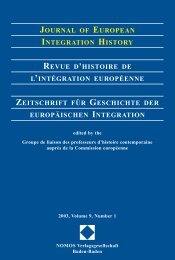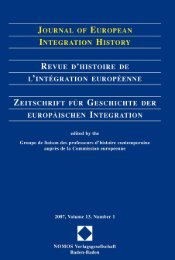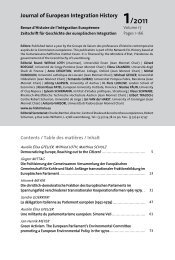journal of european integration history revue d'histoire de l ...
journal of european integration history revue d'histoire de l ...
journal of european integration history revue d'histoire de l ...
Create successful ePaper yourself
Turn your PDF publications into a flip-book with our unique Google optimized e-Paper software.
From Isolation to the Core: Finland's Position towards European Integration 71<br />
neering industries as export branches rose to prominent positions (see figure 2). In accordance<br />
with the original Finnish <strong>integration</strong> aim the traditional export industries<br />
maintained, by and large, their relative competitive position in the Western markets.<br />
While the share <strong>of</strong> timber, pulp and wood manufactures (i.e. plywood) <strong>de</strong>creased consi<strong>de</strong>rably,<br />
that <strong>of</strong> paper and paperboard remained relatively stable.<br />
Figure 2.<br />
Distribution <strong>of</strong> Finnish exports to Western Europe (EFTA + EEC/EC/EU) among sections and selected divisions <strong>of</strong><br />
SITC, 1960-1998<br />
The essential growth has taken place in new export branches. The first feature <strong>of</strong><br />
the <strong>de</strong>velopment <strong>of</strong> a new tra<strong>de</strong> pattern was the emergence <strong>of</strong> product cycles on<br />
some labour-intensive consumer-goods industries. This success was still based on<br />
comparative advantage, i.e. cheap (female) labour. The most successful was the<br />
clothing industry, which, in the beginning, used the wage difference especially with<br />
regard to Swe<strong>de</strong>n and other Nordic countries to allow Finnish exports to find wi<strong>de</strong>r<br />
international markets. Footwear is a similar example but in a smaller scale. The<br />
Finnish basic textile industries, instead, began to <strong>de</strong>cline as soon as tariff protection<br />
ceased. In the 1970s, the share <strong>of</strong> clothing in Finland's total exports rose up to 5<br />
percent, while at the same time that <strong>of</strong> the combined textile, clothing, leather and<br />
footwear industries fluctuated between 7 and 9 percent. The price competitiveness<br />
<strong>of</strong> the Finnish light consumer-goods industries lasted until the 1980s.<br />
After World War II, the Finnish shipbuilding and engineering industries increased<br />
first un<strong>de</strong>r the auspices <strong>of</strong> the Soviet tra<strong>de</strong>, but gradually they gained position<br />
also in Western markets. Finland has been a net exporter <strong>of</strong> ships from the early<br />
post-war years. Most characteristic <strong>of</strong> Finland has been the engineering <strong>of</strong> the<br />
so-called forest cluster, i.e. paper-mills and pulp-mills machinery, woodworking<br />
machinery and forest machines. Also hoisting and excavating machinery have been<br />
successful. From the late 1960s Finland has been a net exporter <strong>of</strong> television receivers.<br />
During the 1990s mobile telephones (Nokia) have become a well-known

















